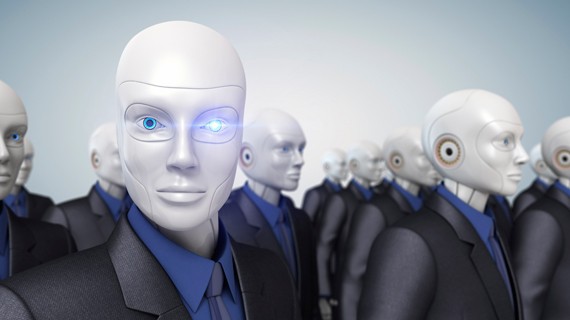Sponsored
Human Legacies When Robots Rule the Earth
Provided byBBVA
While the raw abilities of these computers have improved at an exponential rate over many orders of magnitude, the rate at which human jobs have been displaced has remained modest and relatively constant. This is reasonably because human jobs vary enormously in the computing power required to do those jobs adequately. This suggests that the rate of future job displacement may remain mild and relatively constant even if computing power continues to improve exponentially over a great many more orders of magnitude.
Even if it takes many centuries, however, eventually robots may plausibly do pretty much all the jobs that need doing. A future world dominated by robots could in principle evolve gradually from a world dominated by humans. The basic nature, divisions, and distributions of cities, nations, industries, professions, and firms need not change greatly as machines slowly displace humans on jobs. That is, machines might fit into the social slots that humans had previously occupied.
However, there could also be much larger changes in the organization of a robot society if, as seems plausible, machines are different enough from humans in their relative costs or productivity so as to make substantially different arrangements more efficient.
Human Legacies When Robots Rule the Earth
Read Full Article Today
How might one try to influence such a robot future? One straightforward approach is to accumulate resources, and entrust them to appropriate organizations. Perhaps you dislike the overall nature or structure that a robot society would likely have in a decentralized world with only weak global coordination. In this case, you might try to promote large-scale political institutions, and encourage them to adopt sufficiently strong regulations.
The structures of a future robot society may realistically result from a gradual evolution over time from structures in the most robot-like parts of our society today. In this case, one might hope to influence future structures via our choices today of structures in computer-intensive parts of our society. And if one feared high levels of firm concentration in a particular industry of a future robot society, one might try to promote low levels of firm concentration in that industry today.

It is possible that a future world will be filled with robots similar to the kinds of robots that we have been building for many decades. However, it is also possible to fill a future with a very different kind of robot: brain emulations, also known as “uploads” or “ems”. To make a brain emulation, one takes a particular human brain, scans it to record its particular cell features and connections, and then builds a computer model that processes signals according to those same features and connections. Like humans, ems can learn, and have friends, lovers, bosses, and colleagues. One might talk with it, and convince it to do useful jobs.
The three technologies required to create ems (computing, scanning, and cell modelling) all seem likely to be ready within roughly a century, well before the two to four centuries estimated for ordinary robots to do almost all jobs.
Above we quickly discussed some of the main ways to try to influence a general robot future. How does this situation change for em-based robots? The most obvious difference is that since each em results from scanning a particular human, particular humans can hope to have great influence over the individual ems that result from scanning them. Another big difference is that as ems are very human-like, ems can fit much more directly and easily into the various social slots in the previous human society.
We can expect that, during the em era, em robots would continue to develop the abilities of traditional non-em-based robots. Eventually such robots might become more capable than ems in pretty much all jobs. That could possibly mark the end of the em era. It is less obvious that traditional robots would eventually displace ems than that such robots would eventually displace humans, because ems have more ways to improve over time than do humans. Even so, displacement of ems by traditional robots seems a scenario worth considering.
A transition from ems to traditional robots would possibly be less jarring and more incremental, including and continuing more elements of em minds and the larger arrangements of the em society. And since an em society would also continue more of the arrangements of the prior human society, humans today and their arrangements would face a more incremental path of future change, allowing more ways for people today to influence the future, and creating a future more like the people and institutions of today.
Read the full article here
Deep Dive
Artificial intelligence
Large language models can do jaw-dropping things. But nobody knows exactly why.
And that's a problem. Figuring it out is one of the biggest scientific puzzles of our time and a crucial step towards controlling more powerful future models.
Google DeepMind’s new generative model makes Super Mario–like games from scratch
Genie learns how to control games by watching hours and hours of video. It could help train next-gen robots too.
What’s next for generative video
OpenAI's Sora has raised the bar for AI moviemaking. Here are four things to bear in mind as we wrap our heads around what's coming.
Stay connected
Get the latest updates from
MIT Technology Review
Discover special offers, top stories, upcoming events, and more.